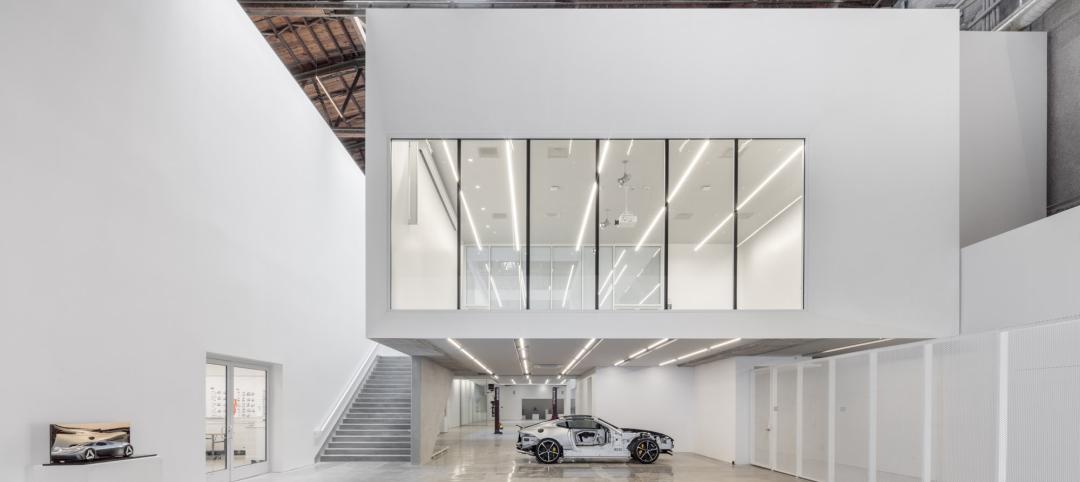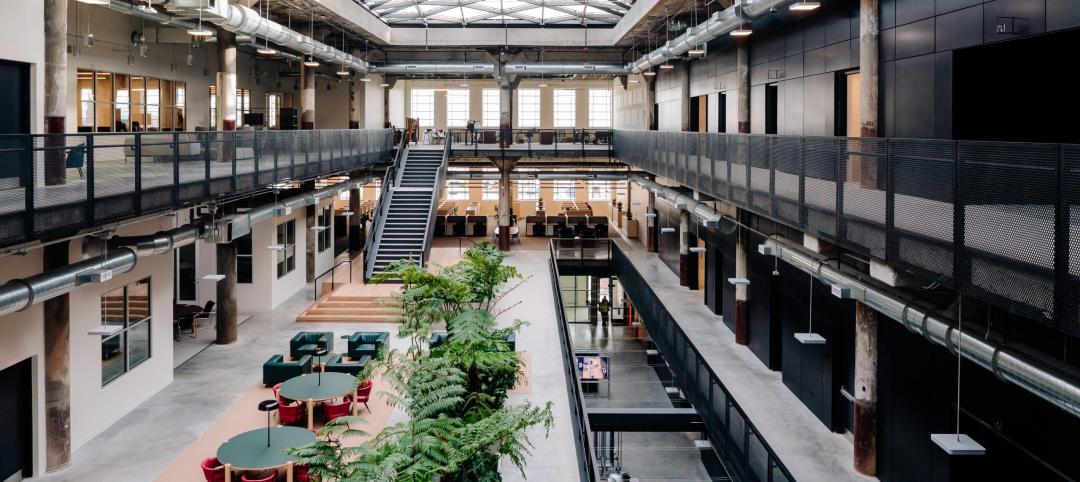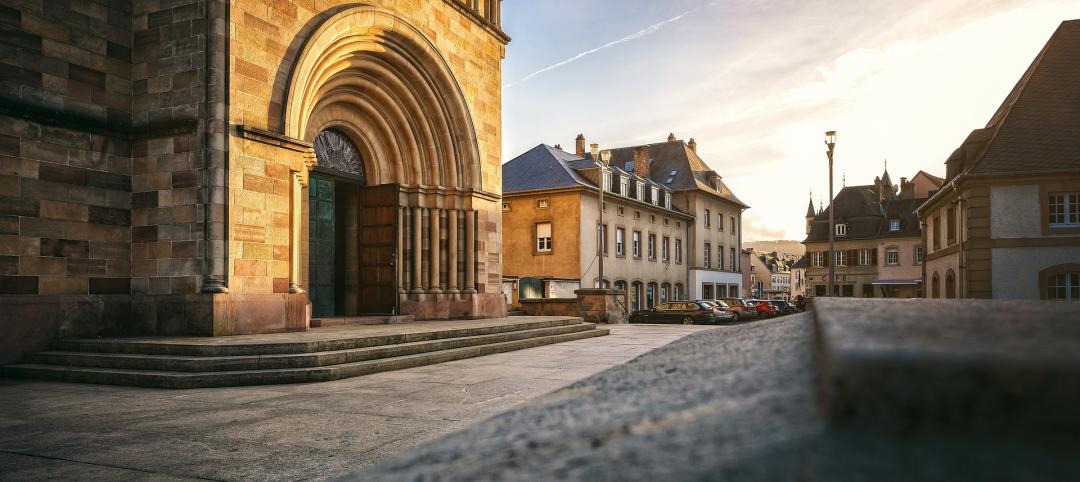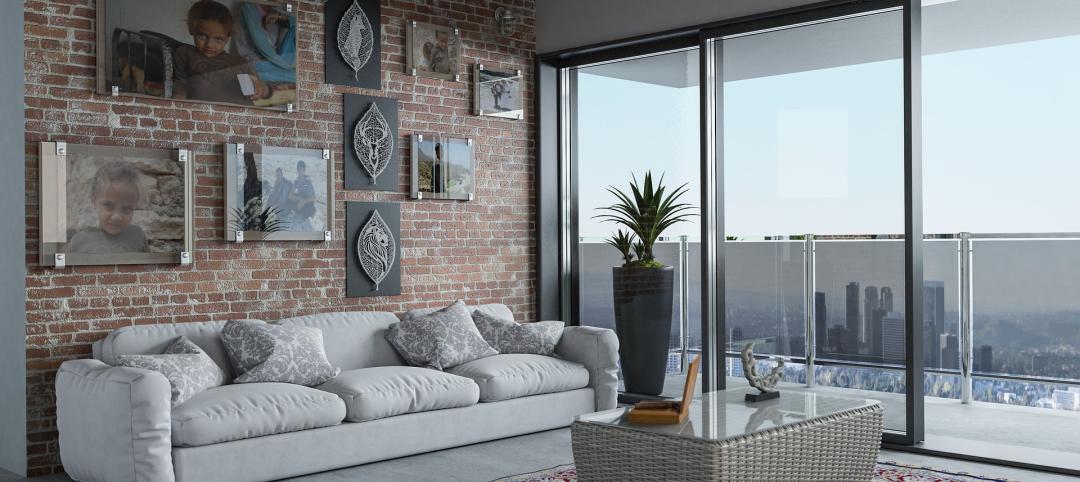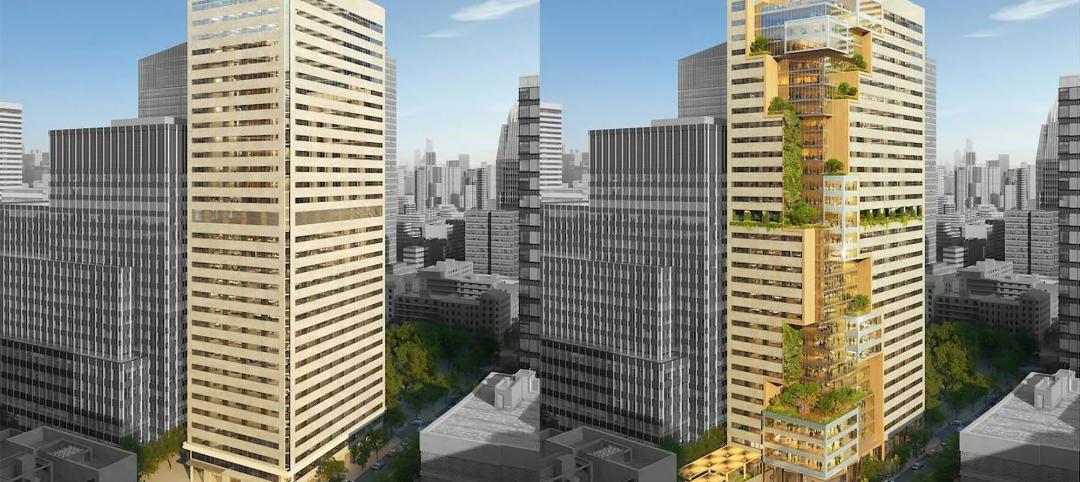Sometime in late Spring of next year, the Hotel Marcel in New Haven, Conn., is scheduled to open. This 110,000-sf, 165-room hotel is being touted by its developer as the first net-zero carbon hotel in the U.S., and its transformation is guided by Passive House and LEED Platinum certification standards.
The former Pirelli Building—named after the famed tire company that bought it as part of Pirelli’s acquisition of Armstrong Tire—was designed in 1967 in the Brutalist style by architect Marcel Breuer. The furniture retailer IKEA, which operates a warehouse right next door, bought the building in 2003, but never used it. In 2018, the city granted permission to repurpose the building—located within New Haven’s Long Wharf district and two miles from Yale University—as a hotel.
The developer Becker + Becker Associates purchased the property—which is listed on the National Historic Register—in January 2020 for a reported $1.2 million. The firm’s President, Bruce Redman Becker, FAIA, AICP, LEED AP, is also the architect on this $50 million restoration project, which will be operated by Chesapeake Hospitality and fall under Hilton’s Tapestry Collection brand. Ten percent of the hotel’s furnishings, including kitchen and vanity countertops, is being supplied by IKEA. The project’s interior designer is Dutch East Design.
DESIGN-BID-BUILD, BUT WITH MORE COLLABORATION

The furniture retailer IKEA owned the Pirelli Building for decades, but never put it to use.
Becker’s interest in sustainable design dates back decades. In 2004, he initiated the “Energy Efficient Housing Technical Correction Act” with New York Congresswoman Carolyn Mahoney. Becker also designed and developed the first two apartment buildings in the U.S. to be powered and heated by a fuel cell.
That latter work drew the attention of the national contractor Consigli, which is serving as Construction Manager for the Hotel Marcel’s adaptive reuse and historic rehabilitation.
“It was a unique challenge to have a relationship with an architect-owner, and to work collaboratively on design details as they came up,” says Aaron Krueger, LEED AP, Project Manager for Consigli, whom BD+C interviewed with Steven Burke, LEED and WELL Faculty, CPHC, Consigli’s Director of Sustainability.
Consigli came on board in 2019, recalls Krueger, when Becker was looking for a preconstruction partner. Consigli worked with the developer on budgeting as well. (Procurement for this project was unusual, says Krueger, in that Becker himself bought the 1,072 solar panels that will power the hotel from their perches on its roof and parking structure; as well as the building’s windows, which were subject to approval along historic criteria.)
Burke says that, prior to its involvement in Hotel Marcel, Consigli had worked on projects powered by renewable energy before: it currently has eight projects being built to achieve net-zero carbon, and six being built to Passive House standards. (Because Hotel Marcel is a retrofit, its Building Team has been following the International Passive House standard.)
SETTING THE BAR FOR HOTEL ENERGY EFFICIENCY

The Hilton Tapestry-branded Hotel Marcel will offer 165 rooms and suites.
The solar arrays will provide 100% of Hotel Marcel’s electricity for lighting, heating, and cooling. The hotel will include among its amenities 12 on-site Tesla superchargers for electric vehicles. Other sustainable features include Mitsubishi variable refrigerated flow air-source heat pumps, an energy recovery system, and recycled and local construction materials. All lighting will be low-voltage power-over-ethernet LED technology. Energy Use Intensity Rating is projected to be 34 kBtu/ft^2, which is 80% less energy than median EUI for hotels in the United States.
All told, Hotel Marcel is aiming to be 60% more energy efficient than code requirements. To hit that target, the Building Team applied spray foam insulation to seal and increase the R-value of the structure’s exterior, which was tricky, says Krueger, because historic preservation requirements limited the extent to which the building’s precast panels could be altered. (Steven Winter Associates is this project’s engineering consultant, and will conduct a whole-building air-barrier test upon completion of this rehabilitation.)
Some of the project’s other challenges included the fact that the building “was filled with hazardous materials, and there was little access to the inside, which really wasn’t abated until last summer,” says Krueger.
Once completed, the building’s penthouse will serve as a 7,000-sf event space for the hotel. Consigli, says Burke, hopes this project becomes an example for future historic restorations that are economically feasible to execute.
Related Stories
Education Facilities | Aug 4, 2024
A former supersonic wind tunnel becomes a new educational facility for transportation design
The Mullin Transportation Design Center at ArtCenter College of Design in Pasadena, Calif., provides access for full-scale vehicular models, replicating a professional design studio.
Adaptive Reuse | Jul 30, 2024
Empty mall to be converted to UCLA Research Park
UCLA recently acquired a former mall that it will convert into the UCLA Research Park that will house the California Institute for Immunology and Immunotherapy at UCLA and the UCLA Center for Quantum Science and Engineering, as well as programs across other disciplines. The 700,000-sf property, formerly the Westside Pavilion shopping mall, is two miles from the university’s main Westwood campus. Google, which previously leased part of the property, helped enable and support UCLA’s acquisition.
Great Solutions | Jul 23, 2024
41 Great Solutions for architects, engineers, and contractors
AI ChatBots, ambient computing, floating MRIs, low-carbon cement, sunshine on demand, next-generation top-down construction. These and 35 other innovations make up our 2024 Great Solutions Report, which highlights fresh ideas and innovations from leading architecture, engineering, and construction firms.
Adaptive Reuse | Jul 12, 2024
Detroit’s Michigan Central Station, centerpiece of innovation hub, opens
The recently opened Michigan Central Station in Detroit is the centerpiece of a 30-acre technology and cultural hub that will include development of urban transportation solutions. The six-year adaptive reuse project of the 640,000 sf historic station, created by the same architect as New York’s Grand Central Station, is the latest sign of a reinvigorating Detroit.
MFPRO+ News | Jun 24, 2024
‘Yes in God’s Backyard’ movement could create more affordable housing
The so-called “Yes in God’s Backyard” (YIGBY) movement, where houses of worship convert their properties to housing, could help alleviate the serious housing crisis affecting many communities around the country.
Multifamily Housing | Jun 14, 2024
AEC inspections are the key to financially viable office to residential adaptive reuse projects
About a year ago our industry was abuzz with an idea that seemed like a one-shot miracle cure for both the shockingly high rate of office vacancies and the worsening housing shortage. The seemingly simple idea of converting empty office buildings to multifamily residential seemed like an easy and elegant solution. However, in the intervening months we’ve seen only a handful of these conversions, despite near universal enthusiasm for the concept.
Adaptive Reuse | Jun 13, 2024
4 ways to transform old buildings into modern assets
As cities grow, their office inventories remain largely stagnant. Yet despite changes to the market—including the impact of hybrid work—opportunities still exist. Enter: “Midlife Metamorphosis.”
Adaptive Reuse | Jun 6, 2024
Latest phase of London redevelopment completes two new buildings
Developers are creating a neighborhood for 25,000 residents and workers.
MFPRO+ News | Jun 3, 2024
New York’s office to residential conversion program draws interest from 64 owners
New York City’s Office Conversion Accelerator Program has been contacted by the owners of 64 commercial buildings interested in converting their properties to residential use.
Adaptive Reuse | May 15, 2024
Modular adaptive reuse of parking structure grants future flexibility
The shift away from excessive parking requirements aligns with a broader movement, encouraging development of more sustainable and affordable housing.



